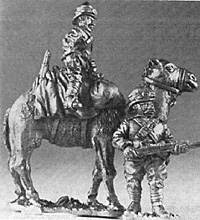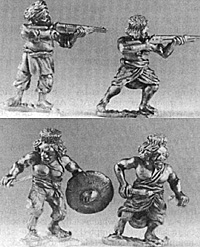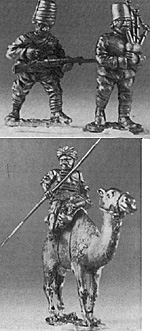
For years Doug Johnson and I have been crying out for some accurate Sudan Wars wargaming figures. Time and again manufacturers have relied on published information by well-meaning historians who have placed far too much reliance on questionable sources.
At right, BRITISH CAMEL CORPS C025 ONCM4 W/COZY
I am happy to say that Essex Miniatures have broken with the past pattern and have turned out the most accurate series of Sudan Wars figures yet seen by this reviewer.
The series contains 30 different numbers, but actually has 55 different figures. This higher number of figures is produced by having up to four different figures for many of the Ansar and "Fuzzy-Wuzzy" numbers. The sculpting is superior and the casting is clean, leaving little or no "flash" to clean off of the figures Animation, for the most part, is very good and the figures all exhibit a certain "personal ity" too often missing in wargaming miniatures.
As I said in a recent SAVAGE AND SOLDIER review of these figures, "the moustaches on the British are just begging to be waxed, and you can almost see the reflection of the Mahdist hordes glistening in their eyes."
Before I begin the review, I'd like to make some general comments regarding the figures. Almost all of the Ansar and "Fuzzy-Wuzzy" figures are supplied with separate weapons -the exceptions being CO 5, 7 12, 13 and 14.
 At right, (top) Fuzzy Wuzzy CO9/CO10 and (bottom) Mahdist CO5, Fuzzy Wuzzy CO12
At right, (top) Fuzzy Wuzzy CO9/CO10 and (bottom) Mahdist CO5, Fuzzy Wuzzy CO12
The Ansar spearmen (CO 1-4) are all supplied with a cast-on sheathed sword and a separate spear. The "Fuzzy-Wuzzy" spearmen (CO 9 and 10) are supplied with loose swords and spears, giving you an even greater opportunity to vary their armament.
The spears all have pretty non-clescript looking blades. The famous "leaf-shaped" spear tips~ are totally absent. For once only a few of the Mahdist figures have shields (as it should be).
The Ansar figure (CO 3) has the oval shield used by some of the Sudanese riverine tribes and the "Fuzzy-Wuzzy" figure (CO 10) has the well-known round hide shield. Both of these shields are supplied as separate "add-on" features, so if you order an assortment of figures, you could distribute the shields among them to further enhance the variety among your native troops. The rifles carried by the Ansar and "Fuzzy-Wuzzies" are definitely Remingtons.
Of the riflemen, only CO 6 has any form of cartridge boxes or belts, and it is a very British-looking looped belt worn around the waist. Where do the other riflemen carry their ammunition? All of the Mahdists are barefoot except for the officer figures (CO 8, 13 and 14).
This seems a bit extreme as sandals were part of the prescribed Ansar uniform, but it is certainly nothing which cannot be lived without. The differences between the figures of the same number generally follow these lines: for the Ansar the variations are in the heads. Some of the men are bald, some are wearing the taggia (skullcap) and some are wearing the imma (turban). Further variation is created with different facial hair-clean shaven, moustache, moustache and beard.
The "Fuzzy-Wuzzies", for the most part, all have the same hair style. Some are clean shaven while others have beards of varying lengths. The real variation in the "Fuzzy-Wuzzies" come in the clothing (or lack of it!). There are four different styles, 1) naked, 2) pants only, 3) skirt-type breech cloth only, and 4) as 3) with the cloth over the left shoulder as well. I should like to add here that all of the variations are not necessarily available for each of the catalog numbers.
The British figures are all dressed and equipped for the early Sudan campaigns. The equipment appears to be the 1882 valise pattern with all the men in light marching order (no valise, blanket roll and mess kit worn low on the hips) with the Oliver pattern canteen. The most glaring questionable detail of the uniform is the puttees. As far as I know, only the Camel Corps, Cavalry and Royal Artillery had adopted puttees in time for the 1884-5 Sudan campaign. Four figures; are cast with separate Martini-Henry rifles (CO 17, 1~ , 3 and 24). This has allowed much more uniform and equipment detail to be cast on the front of the figures. In fact, the rifles of CO 17 and 24 also have the hands attached. They glue very nicely into the cuffs of the tunic sleeves on the main figure. The British Camel (CM 4) is well-equipped with zuleethas (saddle bags), an Egyptian pattern leather water bag (mussek), and other accoutrements.
 At right, (top) SUDANESE C029; EGYPTIAN C028 and (bottom) MAHDIST CAMEL CO15 ON CM1
At right, (top) SUDANESE C029; EGYPTIAN C028 and (bottom) MAHDIST CAMEL CO15 ON CM1
The Egyptian figures (CO 25-28) all have the tall fez (tarboosh). The first two have no tassel, so I suppose they are meant to be wearing the cover on the fez (without neckcloth). The equipment is of the Egyptian pattern and the men are armed with Martini-Henrys. I'm not sure when the Egyptian army officially adopted the Martini-Henry, so I don't know if this is correct. Maybe they should still have Remingtons for the early campaigns with the British.
The piper, (CO 28) is very nice, but I don't know if any of the Egyptian battalions had pipers during the campaigns of the late 1880's. The two Sudanese figures (CO 29 and 30) are wearing fezes with straw immas and battalion 10 flashes. Once again, I'm not sure how applicable this uniform detail is to the earlier Sudan campaigns. They are wearing the looped cartridge bandolier which was unique to the Sudanese battalions. Both the Egyptian and the Sudanese figures have puttees (the officer, CO 27, has gaiters and boots, not puttees) like the British and I'm not sure if this is appropriate or not. The advancing Egyptian (CO 25) and the loading Sudanese (CO 29) are supplied with separate Martini- Henry rifles-that of CO 25 having the hands attached as well.
Included with the review figures was a Pack Camel (CM 3) which is quite nice and well-suited for supply and/or caravan duties. As a final note I'd like to say that the rifles supplied with all of the figures seem to be (and I'd like to stress 'seern') too short. They look more like carbines than full-length rifles, but I don't have access to a real Remington or Martini-Henry to scale them to, so this must remain a purely personal opinion. Now, on to the reviews.
The following review system is based on one which I've used for many years in SAVAGE AND SOLDIER. All figures are rated on a scale of 1 to 5 in four different categories with 1 = Poor and 5 = Excellent.
Category 1 is a rating of the pose. 1 = very awkward, 2 = poor, 3 = acceptable and/or a "stock" pose, 4 good animation, 5 = very realistic.
Category 2 is a rating of the physical characteristics of the figure. IE - is the body proportioned right? Are the arms and legs too thick, or do they bend in the wrong places? Facial expressions and features are also considered in this category.
Category 3 rates the sculpting and accuracy of the figure's uniform, equipment, weapons and general detailing.
Category 4 rates the overall appeal of the figure. This is related to its merits in regards to the first three categories as well as a consideration of the uniqueness of the figure. IE-A Boer artilleryman could be rated high because it is the only figure of a Boer artilleryman on the market. Some of you might think that too much personal bias will affect this rating, but I feel that, considering the fact that I have over 4000 20-25mm Colonial figures (2500 of them painted) from all available manufacturers, that my opinions pretty well reflect those of a typical Colonial wargamer.
Negatives
I have left my negative comments to the end as I feel that they are rather minor and certainly do not distract from the overall excellence of this range of figures. Besides the small uniform and equipment questions which I raised in my general comments, there are three other points I'd like to make.
Firstly, these figures are BIG for 25mm figures. This is not necessarily all Essex's fault. Rather, I think it is more the industry's problem. Unlike model railroading or plastic model kits (where there are established industry-wide scales) wargame figure manufacturers have yet to agree among themselves exactly what defines a given "scale." The case in point, what exactly is 25mm scale? Years ago, Jack Scruby attempted to define the scale as "the height of the figure from the bottom of its foot gear to the top of its head (excluding the head gear)." This means that a 25mm figure would be 25mm tall from the bottom of the boots to the top of the head. Other manufacturers seem to measure to the top of the headgear, and still others measure to the eyes. I'm not sure where Essex measures to as most of these figures are at least 27mm to the eyes, 30mm to the top of the head, and over 30mm to the top of their hair or headgear. The Essex figures literally dwarf some of the 25mm figures on the market (such as Jacklex, Scruby, Ral Partha and even MiniFigs) while they are even taller than the previous 25mm "giants" such as Hinchliffe, Tradition and Garrison. They compare favorably in height to the new Falcon Miniatures 25mm French Foreign Legion figures and to Scruby's older 30mm figures.
My second "negative" observation is that the bases cast onto the figures are very, very small. All of the foot figures will require mounting on larger stands made of cardboard, wood or plastic to avoid continual falling figures and "domino-effect" catastrophes among your units. As most gamers mount their figures anyway, this is not a mjaor fault. The only inconvenience might be to skirmish wargamers or possibly to some THE SWORD AND THE FLAME enthusiasts who have previously not bothered to mount their figures.
Lastly, I'd like to say that I hope this is not the complete range. There are some very obvious (and necessary) figures missing; most noticeably are artillerymen (British, Egyptian and Mahdist), British Naval Brigade, Egyptian and British Cavalry, and Egyptian Camel Corps. Also, it would be very nice to have artillery pieces and machine guns scaled to these figures. I can only hope that these first 30 numbers are only a preliminary release and that more figures will be coming out to complete this excellent range of 25mm Sudan Wars figures.
In conclusion I'd like to say that these figures are superb. They are chock full of detail and personality. The quality of the sculpting and casting are superior. They paint up extremely well. They are well-suited to skirmish wargames or individual figure games such as Yaquinto's THE SWORD AND THE FLAME. They are by far the most accurate range of 25mm Sudan Wars figures yet to be produced by any manufacturer. I highly recommend them and congratulate Essex for their efforts.
| Fig. No | Description | RATINGS | ||||
|---|---|---|---|---|---|---|
| 1 | 2 | 3 | 4 | Notes | ||
| CO 1 | Ansar, attacking w/spear | 4 | 4.5 | 5 | 4.5 | - |
| CO 2 | Ansar, attacking w/spear | 3 | 4.5 | 5 | 4 | 1 |
| CO 3 | Ansar, attacking w/spear & shield | 4.5 | 4.5 | 5 | 5 | - |
| CO 4 | Ansar, throwing spear | 4.5 | 4.5 | 5 | 5 | 2 |
| CO 5 | Ansar rifleman, firing | 3 | 4.5 | 4.5 | 4 | 3 |
| CO 6 | Ansar rifleman, advancing | 4 | 4.5 | 4 | 4 | - |
| CO 7 | Ansar standard bearer | 3 | 4 | 5 | 4 | 4 |
| CO 8 | Ansar foot officer (ra's mi'a) | 4.5 | 4.5 | 5 | 5 | - |
| CO 9 | "Fuzzy-Wuzzy" attacking w/spear | 4 | 4.5 | 5 | 5 | - |
| CO 10 | "Fuzzy-Wuzzy" attacking w/spear & shield | 4.5 | 4.5 | 5 | 5 | - |
| CO 11 | "Fuzzy-Wuzzy" attacking w/rifle | 4 | 4.5 | 4.5 | 4.5 | - |
| CO 12 | "Fuzzy-Wuzzy" firing rifle | 3 | 4.5 | 4.5 | 4 | 3 |
| CO 13 | Amir Chieftan (foot) | 4.5 | 4.5 | 5 | 5 | - |
| CO 14 | Amir Chieftan (mounted) | 4 | 4.5 | 4.5 | 5 | 5 |
| CO 15 | Ansar Camel Rider w/javelin | 4 | 4.5 | 5 | 4.5 | - |
| CO 16 | Ansar Cavalry w/javelin | 3 | 4.5 | 5 | 4 | 3 |
| CO 17 | British Inf., rifle attack ready | 4 | 5 | 4 | 4.5 | - |
| CO 18 | British Inf., firing | 3 | 5 | 4 | 4 | 3 |
| CO 19 | British Inf., loading | 4.5 | 5 | 4 | 4.5 | - |
| CO 20 | British Sergeant | 4.5 | 5 | 4.5 | 5 | - |
| CO 21 | British Bugler | 4 | 5 | 4.5 | 4.5 | 6 |
| CO 22 | British Officer | 4.5 | 5 | 4.5 | 5 | 7 |
| CO 23 | British Camel Corps (mounted) | 4 | 5 | 4.5 | 5 | - |
| CO 24 | British Camel Corps (dismounted) | 4.5 | 5 | 4.5 | 5 | - |
| CO 25 | Egyptian Infantry, advancing | 4.5 | 5 | 4.5 | 5 | - |
| CO 26 | Egyptian Infantry, firing | 3 | 5 | 4.5 | 4 | 3 |
| CO 27 | Egyptian Officer | 4 | 4 | 5 | 4.5 | 8 |
| CO 28 | Egyptian Corporal Bagpiper | 4 | 5 | 4.5 | 5 | - |
| CO 29 | Sudanese Infantry, loading | 4.5 | 5 | 4.5 | 5 | - |
| CO 30 | Sudanese Infantry, firing | 3 | 5 | 4.5 | 4 | 3 |
NOTES
1. Charging on tip-toes. Looks a bit awkward.
2. Throwing spear underhand, like a javelin.
3. "Stock" pose.
4 Bent over too far a little awkward
5. Horse-tail fly-swatter!
8 Quaint rotund fellow but his left arm seems to short
Back to Table of Contents -- Courier Vol. V #3
To Courier List of Issues
To MagWeb Master Magazine List
© Copyright 1984 by The Courier Publishing Company.
This article appears in MagWeb (Magazine Web) on the Internet World Wide Web.
Other military history articles and gaming articles are available at http://www.magweb.com